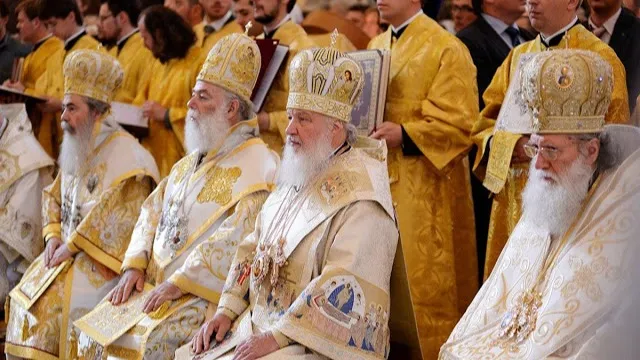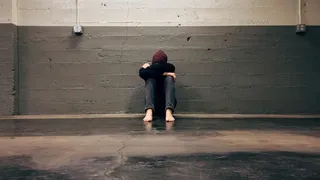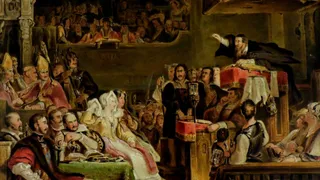The Eastern Orthodox Trick

The Eastern Orthodox claim to be attracting evangelicals. I’ve heard the stories of once devout Bible-believing Christians drawn into Eastern Orthodoxy with the promise of finding the early church. Their biggest obstacle is, perhaps, the icons. At first glance, they appear to be an overt violation of the Second Commandment. To overcome that, Eastern Orthodox Apologists (EOAs) have a common trick they play, changing definitions of icons to make them appear acceptable by God. Here, we see that the first glance was correct, and if you are being beguiled by EOAs' arguments, look out for their trick.
An icon is not just any image. It is not a decoration or art. The Eastern Orthodox admit this explicitly. Hilarion Alfeyev, a bishop of the Russian Orthodox Church, notes, “The icon’s purpose is liturgical.” Hence, “A gallery is the wrong place for icons.”[1] Patricia Miranda explains, “Icons are not ‘art’ in the modern sense of individual expression...”.[2] The Antiochian Orthodox Christian Archdiocese of North America defines an icon as “more than art. . . . The primary purpose of the icon is to aid in worship.”[3] The Orthodox Church of Estonia teaches that icons “come from prayer to be used in prayer and worship.”[4] The sine qua non of an icon is its intentional use in religious devotion. An image, even of a sacred subject, that is not engaged by the worshipper in liturgy, is not an icon. It may only be art, decorative, symbolic, or instructional. Notice how the Eastern Orthodox clearly distinguish between icons and art or decoration in their official teaching to their people.
The Sleight of Hand
Now, the EOAs' trick when trying to woo us outsiders is to pretend that all images are icons. If we say (rightly) that the Second Commandment forbids images used in worship, they will retort that since the Tabernacle and Temple had art; that since Moses made the bronze serpent; that since Joshua bowed before the Ark of the Covenant, then venerating icons is not idolatry.
Did you notice their theological sleight of hand? The Eastern Orthodox, when instructing their insiders, distinguish between art and icons. But now, when defending themselves to us outsiders, they point to the art in the Tabernacle/Temple as evidence of icons. But for those images to be icons, they would have to be used in worship, bowed to, etc. But Israelites did not do that, at least never with God’s approval.
The Tabernacle, Bronze Serpent, & Ark of the Covenant
The art decorating the Tabernacle/Temple was just that: decorations. If they were not venerated, they were not icons. Even when Moses made a bronze serpent and mounted it on a pole, the people of Israel merely needed to look at it (Numbers 21:9). They were not told to bow to it or pay the image any homage. Only look. Jesus made a point of this, with mere looking standing for faith (John 3:14f). Centuries later, however, Israelites had begun to venerate Moses’ bronze serpent. Paganized Israelites offered sacrifices to it. They even gave it a name: “Nehushtan.” It had gone from a benign symbol from Moses’ hands to becoming an icon. Good King Hezekiah did what the faithful always do to icons: He destroyed it (2 Kings 18:4).
As for Joshua bowing “before” the Ark of the Covenant, he was merely “in front of” it. Literally, in Hebrew, the term means 'toward the face', implying simply that he was in the presence of the ark (Joshua 7:6). He was not bowing to it, or venerating it. No one bows to an image in the Bible and is approved of. Even an angel – a truly holy, awe-inspiring being – refused to be worshipped or “venerated” by the Apostle John (Revelation 22:8-9). The angel does not tell John that while worshipping him is forbidden, John can “venerate” him, as if there is a difference. Claiming that doing exactly what the Second Commandment forbids is acceptable as long as we call it “veneration” is akin to claiming that doing what the Seventh Commandment forbids – adultery – is fine as long as we call it “love-making.” Changing the name of an identical activity does not justify it.
Polemics is on Us
We can debate whether or how our church buildings can have art. But there should be no debate that images have no place in Christian worship. Decorations may have a place in worship spaces but they have no place in the act of worship. That’s what the Second Commandment is about.
The early church understood this. Hence, it strictly prohibited icons, as I documented in “Don’t Convert: Icons and Images in the Early Church.” The early church’s strictness against icons was so great it would make most modern evangelicals – with their stained glass, decorative banners, or pictures shown from projectors – seem lax by comparison. I’m not saying that we must return to the rigorous “aniconism” (opposition to icons) of the early church. The Temple decorations suggest we do not have to do so. But we should learn a lesson from the fact that if the church could go from declaring, “Pictures are not to be placed in churches so that they do not become objects of worship and adoration” (Elvira, canon 36) at about AD 305 to full-blown, overt icon veneration by AD 787 (The Second Council of Nicaea) – making images and bowing to them, exactly as prohibited in the Second Commandment – so can we.
The EOAs' disingenuous trick is to argue, to us outsiders, that all symbols, art, and decorations – from Moses’ bronze serpent to the ark of the covenant, to the paintings at Dura-Europos, to your family photos – are “icons.” Thus, they continue, the icons they now use to do exactly what the Second Commandment condemns are acceptable. That’s the trick they’re playing to convert our people. They define icons differently to us outsiders than they do to their insiders. They do it to deceive.
You, a polemics-adverse evangelical, may want to avoid telling your EOA friends what this kind of (dishonest) argument is. But polemics is on you, whether you want it or not.
[1] Original emphasis, Hilarion Alfeyev, “Theology of Icon In The Orthodox Church,” Lecture at St. Vladimir’s Seminary, 5 February 2011, https://mospat.ru/en/2011/02/06/news35783/ [2] Patricia Miranda, “The Tradition Of Iconography,” The National Altar Guild Association, 2011, http://www.nationalaltarguildassociation.org/?p=796. [3] Cindy Egly, “Eastern Orthodox Christians and Iconography,” http://antiochian.org/icons-eastern-orthodoxy [4] “Icons,” http://www.orthodoxa.org/GB/orthodoxy/iconography/whatisaniconGB.htm
Related Articles
Jared Moore | 4/2/2025
How To Respond To Jehovah’s Witnesses
Jehovah's Witnesses believe Jesus isn't God, but was created. What does the Bible say? Here's a quick outline.
Michael Clary | 3/12/2025
The Tyranny of Emotional Pain
Emotional pain is the ultimate con job for a hypersensitive age. Christians care about hurting people, which is why we're so vulnerable to this kind of emotional manipulation. We need to break free from it and refuse to be fragile.
Keith Foskey | 3/10/2025
A Warrior is a Blessing to His People — An Argument Against Christian Pacifism
The Bible condemns vengeance, but does it permit a violence to protect the innocent?
Doug Ponder | 2/28/2025
The Problem with Personality Tests
What if popular personality tests like Enneagram or Myers-Briggs, embraced by many Christians, have serious flaws?
Will Spencer | 2/24/2025
Masculinity Lost and Found: Beyond Tate and the Manosphere
In a world starved for real men, the church faces a showdown with a digital empire built on bravado and sin.
Jacob Tanner | 2/14/2025
John Knox and Lessons on Pastoral Training and Succession
John Knox’s final prayer was for God to raise up true pastors—because without faithful men to teach and preserve the gospel, Christianity cannot endure.





